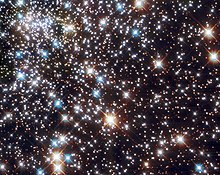Blue trailing star
In astrophysics, a blue straggler (star) (in English, blue straggler) is a main sequence star in a cluster globular or open cluster that is brighter and bluer than those found at the point where the stars in the cluster leave the main sequence of the Hertzsprung-Russell diagram, which plots the luminosity of stars as a function of their effective temperature. Blue stragglers were discovered in 1953 by Allan Sandage by photometric measurements in the globular cluster M3, in the constellation Canes Venatici, and have since been observed in numerous other globular clusters, open clusters, dwarf galaxies, and in the disc of our Galaxy.
Training modes
Blue stragglers are stars that appear younger than the age of the star system to which they belong, if they are assumed to have formed together with it. In the observed Hertzprung-Russell diagrams of, for example, stellar clusters, they appear separate and as extending the main sequence of the cluster, when stars in this position should already have evolved out of that location, according to the standard theory of stellar evolution.
The color of a star is an indicator of its mass and temperature, with blue being hotter than red. The more mass a star has, the more rapidly it burns up its hydrogen, so one would expect a blue giant to take less time than a red dwarf to leave the main sequence. For this reason, when observing the HR diagram of a globular cluster, in which the stars that comprise it have formed at the same time, it would be normal to see an orderly transition from one phase to another; the stars chromatically above a certain level of blue (known as the turnoff point) will have already left the main sequence, reddening and increasing their size, while those, more red and small, they will still be in it. Determining the deviation point can be used to date the age of a cluster.
However, it is quite normal to observe that several stars in a cluster that are on the main sequence have passed the deflection point. These types of stars are known as blue stragglers. The name refers to the fact that such stars seem to have been delayed in their transformation to red giants. The most likely explanation for this phenomenon is that these anomalous stars are the result of stellar collisions or other types of phenomena that involve some type of mass transfer between stars as very close approximations between them. These kinds of events could rejuvenate them by placing them in an odd position on the cluster's HR diagram. In this way, a red star, cold and somewhat old, can gain extra mass from another that passes by or collides with it and become bluer. It happens that, according to statistical calculations, approximations, not to mention collisions or close passes, between stars are very improbable, if not impossible, even close to the galactic nucleus. But things change in globular clusters where the densest clusters of stars are found. Here the laws of probability play differently and such phenomena become a certain but low possibility: thus, for example, in the globular cluster M13 there is only one (Ludendorff 222), a very blue star of magnitude 13.13 in V band
In conclusion, stragglers are initially small red stars late in their main sequence. At a certain moment they obtain stellar mass by approaching and even colliding with a larger star and incorporate it into the one they already had.[citation needed] This increase in mass further compresses the star's core and amplifies the amount of fuel that is fused per second. This entails an increase in luminosity and temperature and a shift in the spectrum towards the blue, so these stars will appear to be younger than they really are. [1]
To study these stars, a group of astronomers have used simulations and observations of the open cluster NGC 188, which is located in the constellation Cepheus, near the pole star. This cluster is one of the oldest open clusters, estimated to be around 7 billion years old, and contains about 3,000 stars. Twenty-one blue stragglers from this cluster have been observed, and the data obtained were analyzed in light of the three main formation theories for blue stragglers: collisions between stars, star mergers, and mass transfer from one star to another. other.
The researchers ruled out the first two hypotheses for most of the stars, since they were in binary systems. In these systems it was observed that the companion star orbits the straggler in periods of around 1000 days, and these companions also turned out to be white dwarfs, so the data points to mass transfer as the cause for the existence of the blue straggler..
In mass transfer, the blue straggler through its gravitational field gradually strips the companion star of its material. This material is extra fuel that allows the straggler to maintain its fusion process and live longer. In this process it leaves the companion star without its outer layers, only with its core, which makes it a white dwarf.
At the moment it has not been possible to observe the companions of the blue stragglers, their existence has been determined by the slight wobble they induce in the straggler due to the gravitational pull they exert on it. This effect also makes it possible to determine the mass of the companions, which is half the mass of the Sun, which is consistent with the fact that they are white dwarfs.
However, while the results explain most of NCG 188's blue stragglers, the researchers note some may have been created by other mechanisms. For example, two of the blue stragglers in binary systems have possibly undergone other types of encounters and even collisions with other stars at some point. Furthermore, 5 of the 21 blue stragglers studied apparently do not have mates, and there is not enough data available to establish their origin.
Contenido relacionado
Galileo (disambiguation)
White dwarf
Brown dwarf

